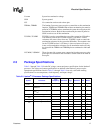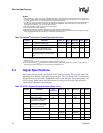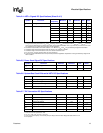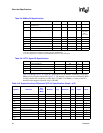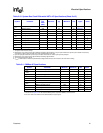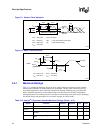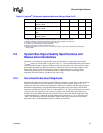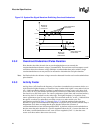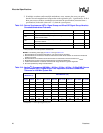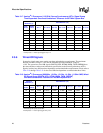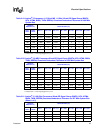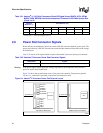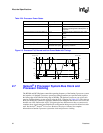
Datasheet 25
Electrical Specifications
Note: AF for the common clock AGTL+ signals is referenced to BCLKn, and BCLKp frequency.
The wired-OR Signals (BINIT#, HIT#, HITM#, BNR#, TND#, BERR#) are common clock
AGTL+ signals.
Note: AF for source synchronous (2x) signals is referenced to STBP#[7:0], and STBN#[7:0].
2.5.4 Reading Overshoot/Undershoot Specification Tables
The overshoot/undershoot specification for the processor is not a simple single value. Instead,
many factors are needed in order to correctly interpret the overshoot/undershoot specification. In
addition to the magnitude of the overshoot, the following parameters must also be known: the
width of the overshoot and the AF. To determine the allowed overshoot for a particular overshoot
event, the following must be done:
1. Determine the signal group that the particular signal falls into. For AGTL+ signals operating
in the 2x source synchronous domain, use Table 2-14 through Table 2-17. If the signal is a
wired-OR AGTL+ signal operating in the common clock domain, use Table 2-18 through
Table 2-21.
2. Determine the magnitude of the overshoot, or the undershoot (relative to GND).
3. Determine the activity factor (how often does this overshoot occur?).
4. Next, from the appropriate specification table, determine the maximum pulse duration (in
nanoseconds) allowed. The pulse duration shown in the table are referring to the period where
either the maximum overshoot (for high phase) and undershoot (for low phase) occurred.
5. Compare the specified maximum pulse duration to the signal being measured. If the pulse
duration measured is less than the pulse duration shown in the table, then the signal meets the
specifications.
6. Undershoot events must be analyzed separately from overshoot events as they are
mutually exclusive.
NOTES: The following notes also apply when reading the Overshoot/Undershoot tables.
1. Absolute Maximum Overshoot magnitude must never be exceeded.
2. Absolute Maximum Overshoot magnitude is measured referenced to GND. Pulse Duration of overshoot is
measured relative to VCTERM.
3. Absolute Maximum Undershoot magnitude and Pulse Duration of undershoot is measured relative to
VCTERM.
4. Ringback below VCTERM cannot be subtracted from overshoots/undershoots.
5. Lesser undershoot does not allocate overshoot with longer duration or greater magnitude.
6. OEM’s are strongly encouraged to follow Intel layout guidelines.
7. All values specified by design characterization.
2.5.5 Determining if a System Meets the Overshoot/Undershoot
Specifications
The overshoot/undershoot specifications listed in Table 2-13 through Table 2-21 specify the
allowable overshoot/undershoot for a single overshoot/undershoot event. However, most systems
will have multiple overshoot and/or undershoot events that each have their own set of parameters
(duration, AF and magnitude). While each overshoot on its own may meet the overshoot
specification, the total impact of all overshoot events may cause the system to fail. A guideline to
ensure a system passes the overshoot and undershoot specifications is shown below:
1. Ensure no signal ever exceeds V
CTERM
or GND.
2. If only one overshoot/undershoot event magnitude occurs, ensure it meets the specifications
listed in Table 2-13 through Table 2-21.



